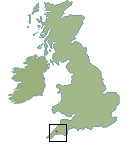Lostwithiel
"There is history in every stone in Lostwithiel"
John Betjeman
The name Lostwithiel conjures dreamy images of a lost yet romantic place. Derived from two old Cornish words, Lostwydhyel translates as 'the place at the tail end of the woodland'. Despite its proximity to the A390, Lostwithiel remains something of a remote destination tucked away in a wooded valley. An excellent spot to get away from it all, Lostwithiel is also a good base for exploring other Cornwall attractions in the area.
During the 13th and 14th centuries, Lostwithiel was at the centre of Cornwall's tin mining trade and rose to become the ancient capital of Cornwall. Its heyday long gone, Lostwithiel has risen to a new eminence as a centre for antiques and collectibles in Cornwall. As well as antique and speciality shops, you can also visit the Lostwithiel Antiques Fair which is held twice monthly.
Lostwithiel is an ancient stannary town that depended heavily on Cornish tin mining for its prosperity. At the turn of the 12th century, Lostwithiel was on the rise and was soon to become the second busiest port on the coast. The town's future was sealed when the Earls of Cornwall made Lostwithiel their administrative centre in the 1270's. They would go on to show Lostwithiel their importance by casting the nearby Restormel Castle into a luxurious mansion. More attractions you can visit in Lostwithiel (thanks to the Earls of Cornwall) are the 14th century bridge with its five tapered arches and the 13th century Duchy Palace on Queen Street. Visitors interested in historic buildings will delight in St Bartholomew's church and its 13th century tower.
In an ironic twist of fate, the very source of Lostwithiel's wealth would also cause its decline. In the 15th century, accumulated waste flowing down from the Bodmin Moors caused the silting up the River Fowey. Lostwithiel soon began to play second fiddle to the main port at Fowey and disappear into a Cornish background.
In the 17th century, drama returned to Lostwithiel during the Great Rebellion in 1644. Lostwithiel was seized by the Parliamentarians and after a long stand-off finally recaptured by the Royalist forces . The siege laid waste to much of the original medieval architecture and much of what you'll see at Lostwithiel was rebuilt after the 17th century.
Attractions near Lostwithiel
Just one mile away, Restormel Castle is an excellent ruins to explore. The 13th century, circular shell keep is well preserved and you'll get good views from the ramparts. Less than 5 miles north west of Lostwithiel, Lanhydrock is a spectacular Victorian mansion and garden which lends an excellent view into the 'upstairs, downstairs' lifestyle of the time. Five miles south is the ancient port of Fowey, another beautiful town in Cornwall boasting the delightful Readymoney Cove and remains of the St. Catherine's Castle.
Closer still, there are some nearby villages and hamlets worth meandering about if you're not rushed for time. The small hamlet of St. Winnow is interesting for its tranquillity and farm museum. Lanlivery which lies on the The Saints Way is remarkable for the 97ft tower at St. Brevita's church. Of more importance is Luxulyan and its granite Treffry Viaduct that once served as a railway and stream through the valley.
Location of Lostwithiel




